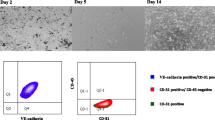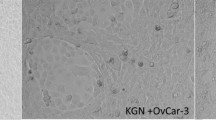Summary
The ovarian mesothelium (OM) represents the tissue of origin of ovarian epithelial cancer. To gain insight into the regulation of this tissue, OM organoids and submesothelial ovarian stromal cells (SC) were isolated from New Zealand White rabbits by a stepwise tissue dispersal technique, while granulosa cells (GC) were aspirated from mature follicles (14±4 groups/animal). OM and SC dispersal were sequentially accomplished by: a) 1-h incubation in collagenase type I (300 U/ml), gentle scraping of the ovarian surface, and 1 g sedimentation of OM organoids (equivalent to 0.93±0.40 × 106 cells/animal) on 5% bovine serum albumin (BSA); b) 2-h incubation in pronase-collagenase (0.5%–300 U/ml) under periodical resuspension and gentle scraping of SC (1.40±0.25 × 106/animal) from OM-denuded ovaries. After a week-long in vitro expansion, OM cells (OMC) were cultured alone and with SC or GC within monocameral vessels or bicameral transfilter vessels in serumless, fibronectinrich (4µg/ml) HL-1 medium. After 7 d of contact cell-cell interaction, cytokeratin-positive OMC became surrounded by fibroblastoid, vimentin-positive SC or by cytokeratin and vimentin-weakly positive GC. Filter-bound OMC humorally interacting with underlying SC or GC displayed a biphasic, epithelioid and spindle, morphology with universal cytokeratin expression. Bromo-2′-deoxyuridine (BrdU) immunoperoxidase revealed mean cell proliferation indices of 14.88% for OMC cultured alone, 11.21% and 19.39% for OMC cultured with GC or SC in monocameral dishes, and 15.25% or 22.47% for OMC cultured in bicameral vessels over GC or SC, respectively. This model provides an experimental tool for investigating the unexplored role of stromal-mesothelial interaction in OM pathobiology.
Similar content being viewed by others
References
Adams, A. T.; Auersperg, N. A cell line, ROSE 199, derived from normal rat ovarian surface epithelium. Exp. Cell Biol. 53:181–188; 1985.
Adashi, E. Y.; Resnik, C. E.; Hurwitz, A., et al. Insulin-like growth factors: the ovarian connection. Hum. Reprod. 6:1213–1219; 1991.
Anderson, E.; Lee, G.; Letourneau, R., et al. Cytological observations of the ovarian epithelium in mammals during the reproductive cycle. J. Morphol. 150:135–166; 1976.
Auersperg, N.; Maclaren, I. A.; Kruk, P. A. Ovarian surface epithelium: autonomous production of connective tissue-type extracellular matrix. Biol. Reprod. 44:717–724; 1991.
Ben Ze’ev, A. Cell-cell interaction and cell configuration related control of cytokeratins and vimentin expression in epithelial cells and fibroblasts. Ann. NY Acad. Sci. 455:597–613; 1985
Bjersing, L.; Cajander, S. Ovulation and the role of the ovarian surface epithelium. Experientia 15:605–608; 1975.
Blaustein, A. Surface (germinal) epithelium and related ovarian neoplasms. Pathol. Annu. 16:247–294; 1981.
Cunha, G. R.; Bigsby, R. M.; Cooke, P. S., et al. Stromal-epithelial interactions in adult organs. Cell Differ. 17:137–148; 1985.
Cunha, G. R.; Donjacour, A. A.; Cooke, P. S., et al. The endocrinology and developmental biology of the prostate. Endocr. Rev. 8:338–362; 1987.
Cunha, G. R.; Chung, L. W. K.; Shannon, J. M., et al. Hormone-induced morphogenesis and growth: role of mesenchymal-epithelial interactions. Recent Prog. Horm. Res. 39:559–598;1983.
Czernobilski, B.; Moll, R.; Levy, R., et al. Coexpression of cytokeratin and vimentin filaments in mesothelial, granulosa and rete ovarii cells of the human ovary. Eur. J. Cell Biol. 37:175–190; 1985.
Elliott, W. M.; Auersperg, N. Growth of normal human ovarian surface epithelial cells in reduced serum and serum-free media. In Vitro Cell Dev. Biol. 29:9–18; 1993.
Forleo, R. Anatomy of the human ovary during pregnancy. Riv. Ostet. Ginecol. 16:530–536; 1961.
Gondos, B. Surface epithelium of the ovary. Possible correlation with ovarian neoplasia. Am. J. Pathol. 81:303–320; 1975.
Grob, H. S. Enzymatic dissection of the mammalian ovary. Science 146:73–74; 1964.
Grobstein, C. Tissue interactions in morphogenesis of mouse embryonic rudiments in vitro. In: Rudnick, D., ed. Aspects of synthesis and order of growth. Princeton: Princeton University Press; 1955:233–256.
Hamilton, T. C. Ovarian cancer, part I: biology. Curr. Probl. Cancer. 16:5–57; 1992.
Hamilton, T. C.; Henderson, W. J.; Eaton, C. Isolation and growth of the rat ovarian germinal epithelium. In: Richards, R. J.; Rajan, K. T., eds. Tissue culture in medical research. Oxford: Pergamon Press; 1980:237–244.
Hamilton, T. C.; Davies, P.; Griffiths, K. Oestrogen receptor-like binding in the surface germinal epithelium of the rat ovary. J. Endocrinol. 95:377–385; 1982.
Hayashi, N.; Cunha, G. R. Mesenchyme-induced changes in the neoplastic characteristics of the Dunning prostatic adenocarcinoma. Cancer Res. 51:4924–4930; 1991.
Higgins, S. J.; Young, P.; Brody, J. R., et al. Induction of functional cytodifferentiation in the epithelium of tissue recombinants. I. Homotypic seminal vesicle recombinants. Development 106:219–234; 1989.
Hill, M.; White, W. E. The growth and regression of follicles in the estrous rabbit. J. Physiol. 80:174–178; 1933.
Hornby, A. E.; Pan, J.; Auersperg, N. Intermediate filaments in rat ovarian surface epithelial cells: changes with neoplastic progression in culture. Biochem. Cell Biol. 70:16–25; 1992.
Hsu, S.; Raine, L.; Fanger, H. The use of avidin-biotin-peroxidase techniques. J. Histochem. Cytochem. 29:577–580; 1981.
Kruk, P. A.; Auersperg, N. Human ovarian surface epithelial cells are capable of physically restructuring extracellular matrix. Am. J. Obstet. Gynecol. 167:1437–1443; 1992.
Luna, L. G. Manual of histologic staining methods of the Armed Forces Institute of Pathology, 3rd ed. New York: McGraw-Hill; 1968:38–39.
Markl, J. Cytokeratins in mesenchymal cells: impact on functional concepts of the diversity of intermediate filament proteins. J. Cell Sci. 98:261–264; 1991.
McNatty, K. P.; Makris, A.; DeGrazia, C. The production of progesterone, androgen, and estrogen by granulosa cells, thecal tissue, and stromal tissue from human ovaries in vitro. J. Clin. Endocrinol. & Metab. 49:687–699; 1979.
Morstyn, G.; Pyke, K.; Gardner, J., et al. Immunohistochemical identification of proliferating cells in organ culture using bromodeoxyuridine and a monoclonal antibody. J. Histochem. Cytochem. 34:697; 1986.
Motta, P. M.; Van Blerkom, J.; Makabe, S. Changes in the surface morphology of ovarian germinal epithelium during the reproductive cycle and in some pathological conditions. J. Submicrosc. Cytol. 12:407–425; 1980.
Murphy, L. J.; Murphy, L. C.; Friesen, H. G. Estrogen-induces insulin-like growth factor-I expression in the rat uterus. Mol. Endocrinol. 1:445–450; 1987.
Nicosia, S. V. Luteinization of rabbit preovulatory granulosa cells cultured in vitro in presence of follicular oocytes. I. Growth characteristics and progestin biosynthesis. Fertil. Steril. 23:791–801; 1972.
Nicosia, S. V. Morphological changes of the human ovary throughout life. In: Serra, G. B., ed. The Ovary. New York: Raven Press; 1983:57–81.
Nicosia, S. V. In vivo and in vitro models for investigating growth and morphogenesis in ovarian mesothelia. Lab. Invest. 64:59; 1991 (abstract).
Nicosia, S. V.; Johnson, J. H. Surface morphology of ovarian mesothelium (surface epithelium) and of other pelvic and extrapelvic mesothelial sites in the rabbit. Int. J. Gynecol. Pathol. 3:239–260; 1984.
Nicosia, S. V.; Johnson, J. H.; Streibel, E. J. Isolation and ultrastructure of rabbit ovarian mesothelium (surface epithelium). Int. J. Gynecol. Pathol. 3:348–360; 1984.
Nicosia, S. V.; Johnson, J. H.; Streibel, E. J. Growth characteristics of rabbit ovarian mesothelial (surface epithelial) cells. Int. J. Gynecol. Pathol. 4:58–74; 1985.
Nicosia, S. V.; Nicosia, R. F. Neoplasm of the ovarian mesothelium. In: Azar, H. A., ed. Pathology of human neoplasms. New York: Raven Press; 1988:435–486.
Nicosia, S. V.; Saunders, B. O.; Narconis, R. J. Regulation and temporal sequence of surface epithelium morphogenesis in the postovulatory rabbit ovary. Prog. Clin. Biol. Res. 296:111–119; 1989.
Nicosia, S. V.; Saunders, B. O. Initial characterization of a luteal growth factor for ovarian mesothelial cells. In: Hirschfield, A., ed. VII. Ovarian workshop: paracrine communication in the ovary. New York: Plenum Press; 1989:237–244.
Nicosia, S. V.; Acevedo-Duncan, M.; Saunders, B. O. Effects of protein and steroid hormone on growth and morphogenesis of ovarian mesothelium. J. Cell Biol. 3:345; 1990 (abstract).
Nicosia, S. V.; Saunders, B. O.; Acevedo-Duncan, M., et al. Pathobiology of ovarian mesothelium. In: Familiari, G.; Makabe, S.; Motta, P. M., eds. Ultrastructure of the ovary. Boston: Kluwer Academic; 1991:287–310.
Osterholzer, H. O.; Johnson, J. H., Nicosia, S. V. An autoradiographic study of the rabbit ovarian surface epithelium before and after ovulation. Biol. Reprod. 33:729–738; 1985.
Osterholzer, H. O.; Streibel, E. J.; Nicosia, S. V. Growth effects of protein hormones on cultured rabbit ovarian surface epithelial cells. Biol. Reprod. 33:247–258; 1985.
Piquette, G. N.; Timms, B. G. Isolation and characterization of rabbit ovarian surface epithelium, granulosa cells, and peritoneal mesothelium in primary culture. In Vitro Cell. Dev. Biol. 26:471–481; 1990.
Sakakura, T.; Sagakami, Y.; Nishizuka, Y. Accelerated mammary cancer development by fetal salivary mesenchyma isografted to adult mouse mammary epithelium. J. Natl. Cancer Inst. 66:953–959; 1981.
Schutte, B.; Reynders, M. M. J.; Bosman, F. T., et al. Studies with anti-bromodeoxyuridine antibodies. II. Simultaneous immunocytochemical detection of antigen expression and DNA synthesis by in vivo labeling of mouse intestinal mucosa. J. Histochem. Cytochem. 35:371–374; 1987.
Siemens, C. H.; Auersperg, N. Serial propagation of human ovarian surface epithelium in tissue culture. J. Cell. Physiol. 134:347–356; 1988.
Silberstein, G. B.; Flanders, K. C.; Roberts, A. B., et al. Regulation of mammary morphogenesis: Evidence for extracellular matrix-mediated inhibition of ductal budding by transforming growth factor-β1. Dev. Biol. 152:354–362; 1992.
Skinner, M. K. Mesenchymal (stromal)-epithelial cell interactions in the testis and ovary which regulate gonadal function. Reprod. Fertil. Dev. 2:237–243; 1990.
Tabibzadeh, S. Human endometrium: an active site of cytokine production and action. Endocr. Rev. 12:272–290; 1991.
VanBlerkom, J.; Motta, P., eds. The cellular basis of mammalian reproduction. Munich: Urban and Schwarzenberg. 1979:5–51.
Author information
Authors and Affiliations
Rights and permissions
About this article
Cite this article
Giacomini, G., Nicosia, S.V., Saunders, B.O. et al. Ovarian mesothelial and extramesothelial cells in interactive culture. In Vitro Cell Dev Biol - Animal 31, 300–309 (1995). https://doi.org/10.1007/BF02634005
Received:
Accepted:
Issue Date:
DOI: https://doi.org/10.1007/BF02634005




